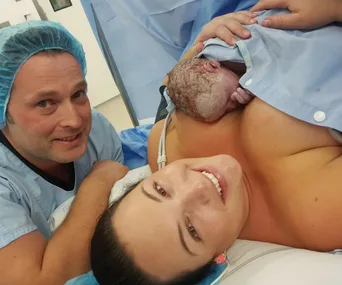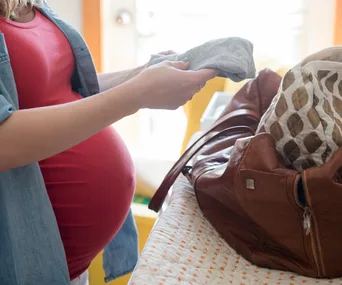Contrary to popular belief, a caesarean or ‘c-section’ is not the “easy way out”. A caesarean section is major abdominal surgery and requires six weeks of recovery time. It involves making an incision in the mother’s abdomen and another in the uterus so that the baby can be lifted out. It can be performed under general anaesthetic, but if you’ve already had an epidural or spinal block, you may be able to remain conscious throughout.
EMERGENCY OR ELECTIVE?
Caesareans are divided into two categories: emergencies — unplanned and performed during labour because of complications — and elective, which are scheduled and take place before labour begins.
An elective, or ‘planned’, caesarean brings an additional set of risks and can increase the pain and recovery time after birth. An elective caesarean would usually only be performed if one or more of the following conditions apply:
• placenta praevia occurs or the
• placenta is functioning poorly.
• the baby is in an abnormal or breech position.
• the mother has diabetes or an active genital herpes infection, or has had problems with a previous birth.
• there’s a known cephalopelvic disproportion (the baby’s head is too big for the mother’s pelvis).
An emergency caesarean would usually be called for if:
• the baby’s head doesn’t descend.
• the mother or baby is distressed.
• the labour becomes obstructed.
• the umbilical cord prolapses (it slips down first, possibly cutting the baby’s circulation).
• there’s excessive bleeding.

A caesarean section is major abdominal surgery and requires six weeks of recovery time. (Image: Getty Images)
WHAT TO EXPECT
Whatever the reason behind your caesarean, the procedure is generally the same. For either an elective or emergency caesarean, informed consent must be obtained.
With any caesarean, you will be wheeled into theatre where you and your partner will meet the team of people who’ll be caring for you, including the anaesthetist and nurse, the theatre scrub team, the assistant surgeon, midwife and often a neonatologist to look after the baby.
A number of procedures will happen in the first five minutes: you’ll be dressed in a gown, shaved in the pubic area (around your lower abdomen), have surgical stockings put on both legs to prevent thrombosis, be given aspirin and antibiotics, put on an intravenous drip and have a catheter inserted into your bladder.
Most caesareans are done using a spinal block, epidural or a combination of both. A spinal block is a single injection into the spine with a fine needle and can be done very quickly. Epidurals take longer to set up but, unlike spinals, they can then be topped up to numb any pain after the operation. General anesthetic is used rarely nowadays. Once the anaesthetic kicks in, you’re minutes away from meeting your baby.
THE PROCEDURE
During the operation, you will be lying on the theatre table with a screen blocking your view below the waist — your partner can either stay up by your head or hover at the other end if he wants a better view. The obstetrician will make a 12-18cm cut below your bikini line, through the abdominal wall and into the uterus. Most women then describe a tugging or rummaging sensation as the baby is pulled out.
The doctor will hold him up for you to see before a midwife checks him over. If all is well, he is then handed to you or your partner for a cuddle and the all-important skin-to-skin contact. Once your baby is out, the placenta is removed by the obstetrician and you are stitched up with dissolving stitches or staples. The whole procedure takes around 30 minutes, and you’ll then be wheeled to a private recovery room. Despite the myths, there’s no reason you can’t breastfeed straightaway.
A few hours later, you’ll be moved to the maternity ward, but recovery times after a caesarean differ from woman to woman. From the start, you’ll most likely be able to sit up with your baby in your arms. But you may be too sore to bend and pick him up, so he’ll have to be passed to you by visitors or a nurse.
You’ll be given painkillers and will be encouraged to start walking as soon as you can, too – at least by the next day. Your internal stitches will be dissolvable ones and external stitches will be removed around day five.
Most women will be able to go home after four or five days, once their pain is under control and their bladder and bowels are working normally..
MANAGING EXPECTATIONS
A caesarean is a major operation and whether it is planned or emergency c-section, it’s important to focus on the outcome of a healthy mum and a healthy baby.

